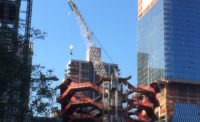Ten Minutes With Gilbane's Tony O'Dea

Tony O’Dea, corporate safety director of Gilbane Building Co., says the key to safety is a culture where workers speak up about hazards and at-risk behaviors. Photo by Wes Cotter.
Tony O’Dea is vice president and corporate safety director of Providence, R.I.,-based Gilbane Building Co., where he has worked for 11 years. A graduate of Northeastern University, O’Dea started out in construction as an engineer and project manager and then served for 20 years as the business unit safety manager in the industrial and infrastructure group of Fluor Corp. He talked recently with ENR Deputy Editor Richard Korman about the state of construction safety, which leading indicators are most important to monitor and how to cultivate a workplace where craft workers are respected and empowered to speak out to help avoid accidents.
ENR Jobsite safety has evolved into a multidisciplinary field that encompasses human behavior and psychology, data analysis and everything in between. Is one approach worth stressing over another?
O’Dea Eliminating injuries has challenged employers and regulatory agencies since the industrial revolution and while consultants emphasize different approaches, we find no one off-the-shelf system that can address all the complexities of weather, logistics, schedule, training, language, equipment operation and communication. All of these affect safe and successful execution. And safety programs have to focus on all areas that contribute to successful programs.
How does that work at Gilbane?
In my view the catalyst is leadership, not just as a position, but as an action that communicates and enforces expectations and provides the conditions and resources to support safe and productive work. Where hazards are planned out of the work and are regularly assessed and corrected immediately when observed. Where leaders set the example themselves.
What leading-edge indicators does Gilbane track?
There are several indicators we include as deliverables within our safety strategic plans and project and regional OSHA [Occupational Safety and Health Administration] partnerships. They include inspections conducted, hazards corrected and recognition awards given. We monitor these and work with all members of the project team and collectively review their effectiveness. We know that these indicators support successful injury- and incident-free projects.
With so many subcontractors and suppliers needing access to jobsites, is there a tendency toward chaos? How will workers who may be involved in 50 projects a year understand the differences among the projects?
Studies have shown that workers are most in danger in the first 30 days they are on a jobsite. Every project has unique hazards, layouts, and organization. Left unmanaged, there can be a tendency for disorganization and miscommunications. You can’t over-organize and over-communicate, especially where multiple contractors are installing segments of work in the same space. You need a well-informed plan led by competent leadership.
Is training of craft workers enough to make the jobsite safe?
Effective safety programs ensure that all the team members on a project have the training and equipment to perform the job safely and efficiently and you have to involve the team members in the safety program by engaging their feedback. We encourage workers to speak up.
Speaking up can be controversial….
At safety orientation, we don’t merely communicate rules to new craftworkers, we try to get to know each other. One subtle thing we do is we make sure everybody puts their first name on their hardhats. That changes how people talk to each other on a project so that they are talking to rather than talking at each other. It changes the dialogue and makes it more respectful and that continues throughout the project. We don’t belittle and shame a worker engaged in unsafe behaviors. I know that approach may be typical or historical in construction but it also is very ineffective. Construction professionals deserve respect not just for what they do but for who they are, and so we try to constructively correct unsafe behavior.
We do this before someone feels disenfranchised and hesitates to speak up, because if this happens, the safety culture has failed and someone could get hurt.
Does speaking up include stopping work?
Gilbane actually has a stop-work award in the form of a personal letter from our chief executive that’s given to employees and contractors for stopping unsafe work or hazardous or risky activity that could lead to injury. We have that award because we want to encourage people to speak up and we have many examples of subs and contractors that intervene with courage to speak up to prevent someone from getting hurt. In the last five years, because we apply above-OSHA fall-protection requirements, and because of the level of acceptance and application by our contractors and crews, we have saved 19 lives in falls that could have been fatal.
Gilbane’s logo includes the words “Gilbane Cares,” the silhouetted image of a person in a hardhat leading a child by the hand, and the phrase, “Because we’re all one family.” Can any company live up to that?
Yes, and it’s vital and necessary. In construction everything we do can affect everyone around us. We need everyone to be their brother’s keeper, to be a lifeguard in the pool. How you do that is to create an environment where people respect each other and see one another not as a means to an end or as an unidentified mechanic or, to use terms from the industry’s past, not to see other people as hands or bodies. Instead, you see them as having the same aspirations and family concerns and working in the same environment and needing to support each other.
And do you think that approach and feeling can carry over after a subcontractor’s people leaves a Gilbane project to go work on another project?
We hope so, because our ultimate goal is to transform safety in the construction industry. We’d love every contractor to adopt this.




